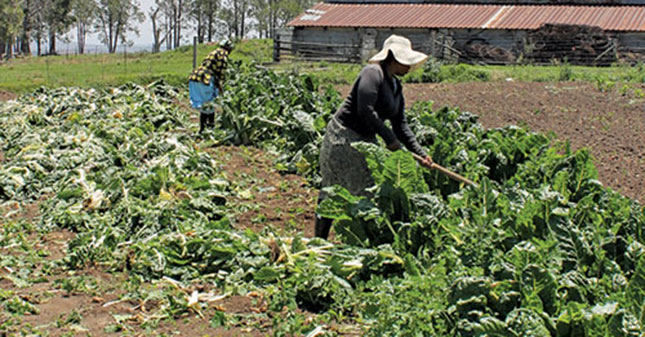Government seems torn between two land reform approaches, with the Department of Rural Development and Land Reform’s (DRDLR’s) policy papers on the one hand and the National Development Plan’s (NDP’s) principles on the other. Which is more likely to succeed?
We believe that the National Development Plan’s land reform model, while it does not have all the details, certainly provides the framework for the better probability of success. The reason is really simple: it’s based on commercial principles and the market system. It speaks about maintaining the integrity of the land market, fair valuation of property, and creating an environment conducive to investment by farmers and agribusiness.
It’s essentially a growth model for agriculture. There are some of the policies in the DRDLR’s model that can work. We’ve been involved in many of the consultations around policy and legislation with the department. There are two draft policies from the DRDLR that are problematic to us and will have a negative impact on agriculture and food security in the long run.
The land reform process creates uncertainty and despite that the agricultural sector boasts a trade surplus. Why is that?
It certainly does appear to be an anomaly, but you firstly need to distinguish between the roles of net farm income and capital formation, the latter being investment in agriculture. In real terms, investment in primary agriculture has been very flat over the past number of years. There has been investment in agriculture, but it’s ‘maintenance’ investment to maintain operational efficiency. Overall, there isn’t much investment in greenfield projects.
In other words, farmers need to replace tractors, rebuild a packhouse, and so forth. If you look at new primary agricultural investment, it’s quite low in agriculture and a concern. Where the gains in efficiency are actually coming from is through new technology and improved management. The productivity on the existing structures, or capital employed, is much improved. You can see it through the huge increases in maize yield and other productivity parameters.
This is what the market demands from farmers as well. If you’re not increasing your productivity, you’re going to be kicked out by the market. We believe that the uncertainty around land reform is having a negative impact on investment. The potential to grow agriculture even faster in South Africa is there. While agriculture is robust and resilient, it is despite some of the negative sentiment. In the face of much adversity, South Africa has a sector to be extremely proud of.
The NDP doesn’t refer to land ceilings, yet the government is busy preparing legislation to that effect. What is the problem with land ceilings?
If you compromise on the principle of land ceilings, then the argument begins on how to set and implement these ceilings. This is where we think it becomes a very unfair and arbitrary system that government can change at their whim. Government might at some stage want 10ha plots or 50ha plots. Can you farm that profitably and sustainably in the South African context? I don’t think so. Economies of scale are an important factor across the world and in many of South Africa’s agricultural industries. The trend of operational consolidation isn’t only in South Africa, it’s worldwide.
And how do you start implementing land ceilings at district level? In a specific district you might have high-potential and low-potential areas, irrigation areas and dryland areas, and cropping areas and grazing areas. Also, some farms are mixed. How will you decide whether a farm should be 50ha, 100ha, 1 000ha or 10 000ha?
We say the market system remains the best way of regulating land ownership patterns for economic and food security considerations. If you’re not using lands profitably and productively, you’re not going to get the returns on that land. In other words, it will be dead capital. In fact, if you’re not using that land, the land devalues because it’s not being developed through good agricultural practice. It will become a burden and eventually come onto the market, as the owner will be able to receive higher returns on, for instance, the stock market.
Where there are highly excessive land holdings in a district, and there may be such examples, it should rather be looked at by the proposed district land commissions ad hoc. Such a farmer could be incentivised or moved to go into joint ventures with black farmers on some of his land. But this should be the exception.
Do you think the NDP’s target of one million jobs in agriculture by 2030 is achievable?
Realistically, given the current investment climate and policy situation, I don’t think it’s possible. That whole study was premised on an ideal policy situation and an ideal supportive situation from government. The challenges that government and the private sector face, and the objectives they have, are not always the same. If we don’t fully understand what these challenges and objectives are, then we have a problem. In the private sector, we try our best to facilitate an environment conducive to investment.
Compounding the situation are other factors such as disruptions in electricity supply, inability to access new electricity connections, and the unsatisfactory labour relations environment. If we do get the environment for investment right, it’s possible to turn the long- term trend of net job losses in agriculture around. The sector has been shedding jobs for decades now and this is a function of the productivity imperative. I don’t know whether we’d get to a million jobs, but at least we could turn the trend around to make it a net creator of jobs again.
Job creation is a lag indicator. You first need to get the investment climate right, then you get the investment, and then you get the growth. Only after that will you start to employ more people. You don’t start a business simply to create jobs.
The rest of Africa became the biggest destination of SA agricultural exports last year. Why did it happen and are there any transport cost benefits to producers?
Africa’s transport infrastructure generally isn’t good, and using it isn’t cost-effective. Many harbours, railways and roads are in poor condition, and not particularly well managed. It’s probably cheaper, although it’s further, to export to Europe than to Africa. One of the ways to solve this problem is to fly your higher-valued fruit into the markets, but this is expensive.
Despite this, Africa’s GDP is growing at close to 6% per annum, as we’ve seen over the past 10 years. The per capita income of people in these countries has already gone up significantly, and is still increasing. Their discretionary household expenditure has increased and the broader population now have more money to buy food products of choice. South African, and other, supermarkets have opened many outlets across Africa, especially Shoprite, Pick n Pay and Woolworths.
People want to have the supermarket shopping experience and buy the brands. It’s a normal, well-documented phenomenon worldwide. As this supermarket phenomenon expands across Africa, while the continent urbanises, people need to buy food, and they do it at supermarkets. This supermarket phenomenon has created a demand for, amongst others, South African processed products and even high-value fruit. Apples are a good example where marketing has seen a massive increase in exports to Africa.
Has agribusinesses joined the trek into Africa?
Yes, it’s the whole value chain that’s developing in Africa. If you look at production, you’ll also need financing. South African commercial banks have a significant footprint on the continent. When you have finance, you also need insurance to mitigate the risks. The insurance companies are already moving into Africa in significant numbers. Many agribusinesses – Afgri, NWK, Senwes, Kaap Agri and Astral Foods, for example – have also moved into Africa. Agricultural machinery companies, such as John Deere, have done the same. It’s not always easy to do business in Africa, but there’s opportunity in the emerging African food value chains.
Phone Agbiz on 012 807 6686.













